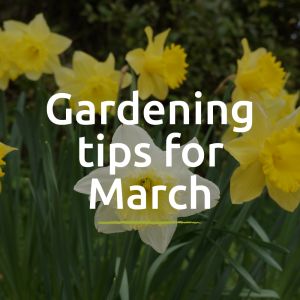Garden tips for March
It’s March already, which can only mean one thing – spring is on its way!
February may have been cold and brisk, but in many ways a lot milder than we have seen it in recent years, which means flowers and crops have started to grow early as the soil has become warmer.
However, winter wasn’t quite done and many of us have seen how fickle the weather can be early on in the year. Spring may have been in the air, but snow blizzards followed by blue skies and sun have led to a confused March!
If you have had heavy snow, you may need to push back some of your plans until the soil dries a little, but there is still plenty to do.
We’re still in the throes of planning, but have spent a lot of time outdoors. Weeding (yes, they are back!), pruning and a good spring clean has taken place with fallen leaves still being raked as new buds push out the old leaves still hanging on by a thread.
Snowdrops, narcissus and early-spring bulbs are coming through and whilst we will lose and hour in bed when the clocks go forward, it will mean the evenings get longer.
March is a time when we finish off those winter jobs and welcome spring with open arms. It’s time to dust off those gardening gloves, getting snipping with those secateurs and take in spring’s beauty as the garden transforms from autumnal hues into bright, vibrant colour.
Blooming March
- Pruning is still essential as we enter March. Roses, clematis and winter jasmine all will need trimming and pruning. However, don’t prune late-winter/early-spring flowers until they have stopped flowering.
- Spring is the time to plant lilies and other summer flowering bulbs.
- Split clumps of snowdrops and re-plant.
- Continue to deadhead winter flowers.
- Finish pruning ornamental grasses, rhododendrons and flowering heathers as soon as the flowers finish.
- If you have ordered any plug plants, take them out and re-pot them as soon as they arrive. Keep in a warm place, such as the greenhouse.
- Sow wildflowers and start thinking about those hanging baskets. Hanging baskets are great for planting strawberries and tomatoes amongst flowers.
- Feed the soil with a slow-release fertiliser such as Fish, Blood and Bone.
- Bare root plants such as roses can still be planted.
- As plants start to grow, start to feed more regularly. Specialist feeds such as Vitax Ericaceous Feed, Fuchsia Feed and Hydrangea Feed will provide the right nutrients for the right plant.
- If you’ve used bubble wrap or fleece to protect less hardy plants, as the weather warms, this can be removed. However, be guided by the weather as heavy ground frosts are not unknown well into March.
- Top dress containers and pots and lightly incorporate into the top soil. Vitax Q4 All Purpose Plant Food is a great all-rounder and gives a quick initial boost and then slow release nutrients.
- And, don’t forget those houseplants! Check the soil and start to water more regularly, as well as looking at increasing nutrients as they start to blossom.
- Regularly move houseplants to maximise the use of natural light.
Grow Your Own
- It’s time to sow, sow, sow and plant, plant, plant for bountiful crops!
- Plant out onion and shallot sets if you haven’t already done so.
- Sow early carrots under fleece or cloches to prevent pest infestations. As the soil starts to warm, think about sowing other root vegetables, such as parsnips and turnips.
- Start off celery, lettuces, celeriac, squash etc in the greenhouse.
- Start sowing hardy vegetables such as peas, kale and radishes.
- If you’ve not already started them off, tomatoes, chillies etc can start to be sown in the greenhouse.
- As soon as the soil is ready towards late March when we’ve seen some spring sun, plant rhubarb crowns and vegetables such as asparagus.
- If you still have fruit and vegetables in cold store, check for rot and remove to protect healthy crops.
- Bare-root trees such as apples, plums, peach and apricots can now be planted.
- Fruit bushes such as gooseberries and cranberries can also be planted.
- For established trees and shrubs, work in a slow release fertiliser such as Vitax Conifer & Shrub.
Pests & general care
- Whilst they never fully hide in winter, spring is a festive feast for pests and bugs as they fully wake from their winter slumber, so preparation is key.
- If you winter washed and protected your trees, then expect fewer bugs, but if not, you can still protect against crawling pests by adding tree bands.
- Slugs love pretty much anything. Hostas are a particular delicacy as well as all those new shoots. Deter slugs with Vitax Slug Gone. The organic wool pellets natural fibres make for a challenging, itchy terrain but make sure you fully cover the base of the plant, including reaching beyond any over-hanging leaves as slugs have ninja like skills!
- Check new shoots for aphids. This early in the season, you should be able to pick them off if there are not too many.
- Tidy those borders and mulch. Adding a soil conditioner such as 6X Natural Plant Feed will give the soil a boost.
- Weeds will now start to take over if you don’t keep them under control. Regularly hoe and remove.
- If the soil is heavy, improve drainage by adding perlite.
- If you haven’t already, clean empty pots and containers ready for planting.
Lawns and hedges
- Inspect buxus for box blight and set box tree moth traps.
- Feed buxus with a specialist feed such as Buxus Feed.
- If possible, still keep off lawned areas if heavy with snow or waterlogged once it’s thawed. If you need to walk on grass, use boards to protect the turf’s structure.
- Once the lawn has started to dry, treat it with a lawn feed. Vitax’s new Organic Lawn Feed is ideal for organic gardens and will help strengthen the lawn following the stress of winter.
- Install lawn edging to keep it in check. If warm and starting to grow, mow on the highest setting to just take the top off.
The long wait is over. Nights are getting longer and hopefully by the end of March the weather will be warmer. New shoots will make all the winter preparation worthwhile and those early spring blooms covered by snow will start to bloom again, filling the garden with colour and scents of the new season.
Now is the time to start and enjoy the garden as we move into a new season!
Your login details have been used by another user or machine. Login details can only be used once at any one time so you have therefore automatically been logged out. Please contact your sites administrator if you believe this other user or machine has unauthorised access.














